Statistical physics of flowing crowds (MSC/BSC)
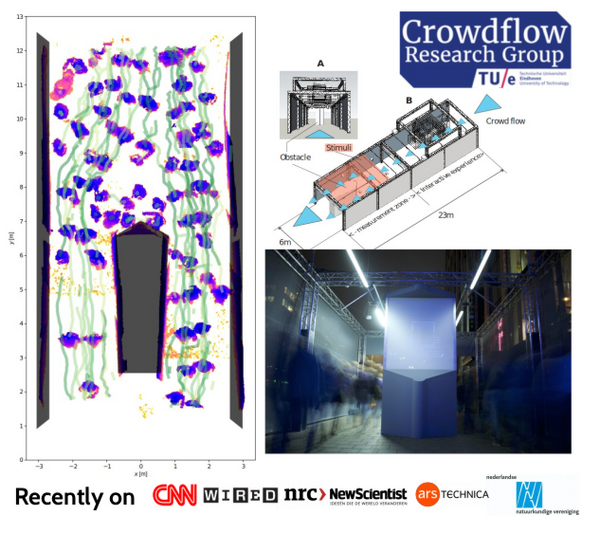
Which features do (active) fluid flows and crowds of walking pedestrians have in common?
Can we accurately measure, predict and possibly nudge the dynamics of human crowds?
We offer all year round MSC and BSC projects on a wide range of topics which mix fundamental physics research and cutting-edge technological development. We welcome applications from students with strong interest in theoretical and statistical physics as well as in state-of-the art IT challenges. Typical activities involve one or more among: development of quantitative (particle-/lattice-/path-integral-based) mathematical models for crowds to be compared with real-life data; big-data analytics of real-life crowd dynamics datasets to unveil fundamental features of crowd motion; sensor development for millimeter accurate crowd tracking (through depth-sensors and/or CCD in connection with deep learning methods); realization of real-life experimental campaigns to investigate, e.g., steering strategies for pedestrian flows.
More information on past research activities: crowdflow.phys.tue.nl
Alessandro Corbetta, Federico Toschi
Contact: Federico Toschi
The physics of dense emulsions and earthquakes avalanches “in silico” (MSc/BSc)
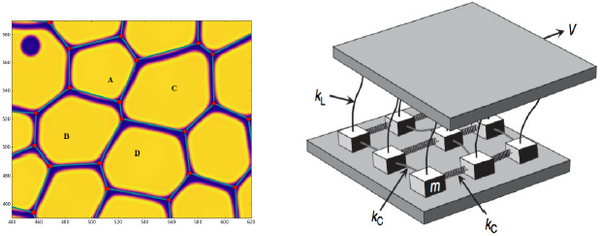
Numerical studies on slip-stick faulting have until now depended on ad-hoc constitutive laws which for most cases are not known a-priori. A novel formulation based on the multicomponent Lattice Boltzmann method* has been developed to find a quantitative connection between the physics of complex soft-glassy materials below yield stress and the dynamics of stick-slip faulting events leading to earthquakes. Synthetic earthquake catalogs are being generated from plastic events (stick-slip causing topological changes) occurring in a sheared emulsion of poly-disperse droplets, using an in-house code developed of the method mentioned above. The student will use tools of statistical physics to benchmark these catalogs against classical earthquake models like the 2D Burridge-Knopoff (BR) and cellular-automaton based Self Organized Criticality (SOC) –like models.
Pinaki Kumar, Federico Toschi
Contact: Federico Toschi
Living fluids: population growth and genetics (BSc/MSc)
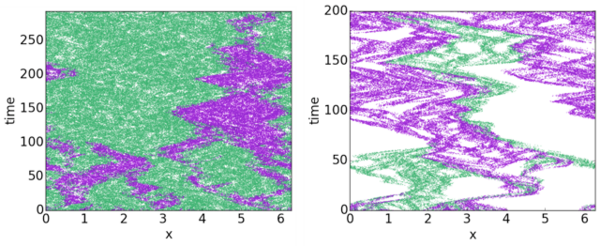
The growth of populations of microorganism is influenced by the ecosystems, including the presence of (turbulent) flows, by competition and/or mutualism amongst species. In this project we will employ numerical simulations capable of accurately describing the dynamics of populations along with their genetics in flowing environments. The numerical studies will allow to investigate key generic quantities such as fixation probabilities and fixation times of mutations, as a function of relevant parameters.
Contact: Federico Toschi or Hanneke Gelderblom
Rayleigh-Bénard convection in rarefied gas (BSc)
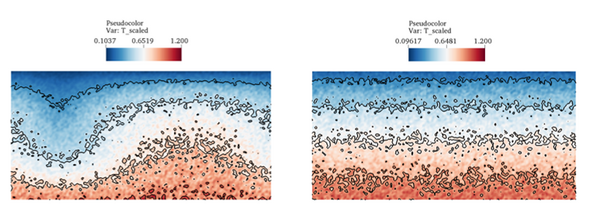
Rarefied gas flows when thermal effects are relevant represent an open challenge from the physics and modelling point of views. The peculiarities they show to possess, such as the temperature jump, anti-Fourier like heat transport and the suppression of natural convection even under super-critical conditions, clearly differentiate them from continuum flows.
In Rayleigh-Bénard convection (RBC), a confined gas is heated from below while cooled from above. By means of a particle-based numerical method, the Direct Simulation Monte Carlo (DSMC), we performed simulations in a 2D set-up showing that natural convection may be suppressed under super-critical conditions even for very mild rarefaction gas conditions (small Kn number). In this project, we want to investigate the influence of the inter-particle collision model choice on this phenomenon. In particular, we want to compare the results on heat transfer already obtained by employing the hard-sphere model with those we will obtain by applying more sophisticated collision models, such as the variable hard-sphere and/or the Maxwell molecules model.
Contact: Federico Toschi or Herman Clercx
Rayleigh-Bénard convection in rarefied gas (MSc)
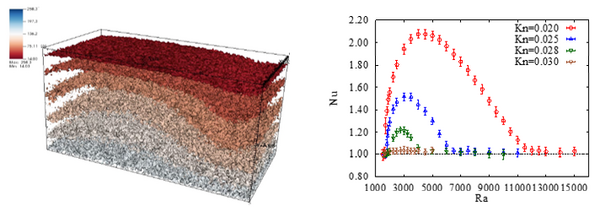
Rarefied gas flows when thermal effects are relevant represent an open challenge from the physics and modelling point of views. The peculiarities they show to possess, such as the temperature jump, anti-Fourier like heat transport and the suppression of natural convection even under super-critical conditions, clearly differentiate them from continuum flows.
In Rayleigh-Bénard convection (RBC), a confined gas is heated from below while cooled from above.
By means of numerical simulations using a particle-based method, - the so-called Direct Simulation Monte Carlo (DSMC) -, we have already found that in 2D RBC under mild rarefied gas conditions (small Kn number), thermal instability may be suppressed even for super-critical conditions. In this project, we want to further investigate the problem to verify if the same phenomenon occurs also in a 3D set-up and to quantitatively evaluate heat transfer. To overcome the extreme computational costs in case DSMC is used, we want to develop and apply a thermal Lattice Boltzmann Method (LBM), a much more efficient numerical method, based on higher-order lattices and the regularization procedure. Besides studying a relatively unexplored field of fluid dynamics, the project requires programming skills and mathematical understanding for the modelling phase.
Contact: Federico Toschi or Herman Clercx
Experimental study of the liquid layer deposition in 3D printing (BSc)

Industrial additive manufacturing (AM), also known as a 3D printing, is considered to be a potential breakthrough production technology for many applications. A specific AM implementation is vat photopolymerization (or stereolithography) which uses a liquid resin out of which an arbitrary geometry can be constructed in a layer-by-layer fashion. UV light is used to selectively solidify parts followed by the deposition of a new liquid layer of resin. The latter process is usually done by a recoater (or blade). Since the quality of the end product significantly depends on the quality of an individual layer, it is crucial to have a flat liquid layer with a certain thickness before the irradiation step. The goal of the project is to explore experimentally the influence of the recoating parameters (e.g. speed of recoater, recoater shape, underlying topography configuration, etc.) on the liquid surface quality. An experimental setup will be provided by TNO, and its sketch is presented in the figure.
Contact: Rudie Kunnen or Herman Clercx
Modelling of the liquid recoating process over topography in 3D printing applications (BSc)

Additive manufacturing (AM), also known as a 3D printing, is widely used as a tool for product development. One of the implementations of AM is based on stereolithography (SL). SL is a process consisting of a continuous repetition of two steps: the solidification of one layer of the liquid photopolymer, and recoating or covering the top of the partially built product with a new liquid layer. Most of modern SL machines use a special device, called blade or recoater, to accomplish that second step. The aim of the recoating step is to obtain a uniformly flat liquid layer with a desirable thickness. In practice, a building part usually have an irregular geometry which makes the recoating process complicated. The project will contribute to the investigation of the relation between geometry of underlying solid part and a free-surface deformation. The first step towards the understanding of the basics of fluid dynamics can be done by means of numerical simulations. The sketch of the possible numerical model is presented in the figure. The study will include the variation of the recoating parameters, such as a blade speed, cavity height and length, etc. and exploring its impact on the flow in the cavity and the free-surface evolution.
Contact: Rudie Kunnen or Herman Clercx
Magnetic Density Separation (MDS) or solving the world’s plastic waste problem (MSc)
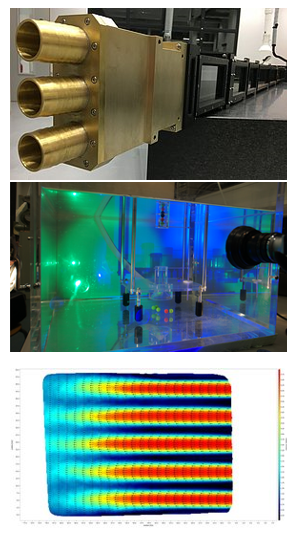
Our group is involved in a large NWO- project on Magnetic Density Separation (MDS) technology for recycling plastic. This project is a collaboration between several universities and industry and has also been featured in the television program "Kassa" https://kassa.bnnvara.nl/media/379650. MDS technology has really the potential to solve the world wide plastic waste problem by introducing new separation methods to fully recycle automatically down to the level of plastic type and color, any plastic that currently is wasted. Currently plastic recycling is hampered by the multitude of different chemical composition of plastics in use. MDS allows sorting different plastics according to small differences in their mass density. For this purpose, plastic objects are cut into 5 mm size flakes and immersed in a magnetic liquid. A magnetic field induces a height- (i.e. z-direction) dependent buoyancy gradient in the fluid. Plastic particles will float at a z-dependent neutral buoyancy level and can thus be separated using magnetic levitation. Our group focuses on the ferrohydrodynamics and fluid dynamics of MDS technology. Key words are: particle-particle interactions in fluids, ferrohydro-dynamics, magnetic levitation, particle motion due to turbulence in fluids, fluid instabilities. For this project we are looking for enthusiastic students that can assist us with the following specific projects:
Project 1: neutral dependency studies of manganese chloride and magnetic fields
More insight is needed concerning the effect of magnetic fields on the magnetic levitation of plastics in a paramagnetic manganese chloride liquid. Experiments are needed to measure the buoyancy effects as a function of magnetic field and concentration of the manganese chloride. The levitation effects have to be compared with theory.
Project 2: particle-particle collisions in fluids
Collisions of particles in the liquid are one of the phenomena limiting the throughput and resolution of magnetic-density separators in plastic recycling technology. To gain an in-depth understanding, experiments will be performed where plastic particles (one heavier than water, one lighter) will be released at the top and the bottom of a transparent water tank. The ensuing collision will be recorded with 4 cameras providing 3D resolution and analyzed using particle-tracking software. The next steps are to study the effect of a turbulence level present in the tank before releasing the particles or to modulate the effective buoyancy forces by using a transparent magnetic fluid.
Project 3: time dependent particle paths in magnetic fluids
The effect of magnetic fields on the particle path are computed by a numerical model that takes into account the buoyancy and drag forces in the fluid. Using a tool such MATLAB, computations are carried out in a time dependent fashion. The effect of turbulence on the particle paths will be studied as well.
Contact: Jos Zeegers
Towards a ferrofluid display (BSc)

Ferrofluids are liquids with a permanent magnetization, which can be manipulated by means of static and dynamic magnetic fields. The figure shows two examples taken from YouTube videos. The goal of the project is to construct a rudimentary display and to characterize parameters such as its response time and the correspondence between the pattern that you want and the pattern that you get. The challenge will be to do reproducible and well-controlled experiments that can be compared with numerical simulations based on the equations of motion of ferrofluids.
Contact: Anton Darhuber